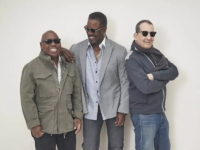How do you react when you hear or read the term “smooth jazz”? Does it conjure up visions of Kenny G flittering up and down scales as he’s swaying with his long, curly locks tousling about and holding his straight sax off to the side of his mouth? Perhaps John Tesh ripping it up (well, maybe not) at Red Rocks? Or Chuck Mangione going above the natural limit of the flugelhorn on “Feel So Good”? If those sounds and visions make you cringe and yet you still dared to come to this page, I’ve got some great news for you: it ain’t all bad.
Matter of fact, some of it’s pretty damned satisfying, if the mood is right.
The term “smooth jazz” didn’t come about until the genre was well on its way in the mid-’80s. But the music had been around at least since Wes Montgomery’s late-career Creed Taylor discs of the mid-’60s. I once heard that Vince Guaraldi’s “Cast Your Fate to The Wind” from 1962 is the first smooth jazz song, and maybe the light, pop-like melody and de-emphasis on improvisation lends some support to that argument. In any case, the genre stayed on the sidelines often mixed in with overlapping styles like new age, Quiet Storm, fusion lite, funk-jazz or jazz-pop until some savvy radio stations sometime around 1987 shaped it into its own format, spawning a new generation of musicians devoted to the hot new idiom and resurrecting some careers of some older jazz musicians. It’s in this golden decade of smooth jazz that we uncover the records that wouldn’t be embarrassing at all to play today.
Actually, finding five great smooth jazz records from the ’80s was so easy, I came up with about 15 before I realized I had enough. So, if I missed any obvious choices among the five below, stay tuned. We can always make more lists…
Grover Washington, Jr. Winelight (1980)
If there’s ever a “well, duh” selection for all-time best smooth jazz list — much less the best of the ’80s — here it is. Coming right at the beginning of the decade, Winelight is in hindsight really a transitional record, after the bumps in the grooves got smoothed out but before adventurous improvisation was replaced by shorter, safer solos that rarely strayed from basic pop melodies. Washington turns in some invested performances using a wide arsenal of saxes over tight grooves, and this was an early flowering of one of smooth jazz/funk jazz greatest bassists, Marcus Miller. He’d go on to play bass on many, many high-profile contemporary jazz and R&B records throughout the decade, including all five of the records on this list. A coincidence, I swear.
The six songs stretched well beyond radio length and even the designated hitter “Just The Two Of Us” had to be chopped down from seven and a half minutes to get airplay but it got plenty of that, reaching No. 2 on the Hot 100. That made it the last in a long string of popular numbers for singer Bill Withers but catapulted Washington to the front ranks of artists of what was then called “rhythm and jazz” and along with Mr. Magic, Winelight became the required Grover Washington album for any respectable contemporary jazz record collection.
Spyro Gyra City Kids (1983)
After their uneven 1977 self-titled debut, any Spyro Gyra album up through this one will do the trick. City Kids gets an ever-so-slight nod for an ever-so-slightly strong overall set of songs. This was also the last album for a while that was heavily supplemented by studio aces, and Kids has plenty in the way of Steve Gadd, Will Lee, Eddie Gomez, Miller, Richard Tee and vibraphonist Dave Samuels, who would soon join the band full time. On here, as on most of their albums, they’re deceptive in their approach to smooth jazz, as there exists tempo and harmonic shifts not so common from their peers. “Conversations” even flirts with straight-ahead jazz.
Spyro Gyra was one of the first smooth jazz bands, but set a template that too few acts after them followed without watering it down. For that reason, along with Jay Beckenstein’s instantly recognizable sax, there’s really no one else like them. City Kids states that case better than most of their albums.
George Benson & Earl Klugh Collaboration (1987)
Benson and Klugh are undeniably terrific plectrists, and it comes through on every record they make. That doesn’t mean they always make terrific records and in Benson’s case, he had been steadily drifting away from jazz since the turn of the ’80s; by 1986’s While the City Sleeps he had transformed into a pop singer.
Collaboration is a return not to the real jazz he made in the 60s but the still-viable crossover jazz of the late ’70s, even going as far as bringing back his old producer from that era, Tommy LiPuma. Pop-jazz acoustic guitar champ Klugh joins him in a full co-lead role, and Collaboration can be seen as a continuation of what got started with the co-written, co-performed title track to Benson’s Living Inside Your Love LP from 1979. No singing on this one, save for Benson scatting on “Mt. Airy Road” and the title cut, and the material is overall much better than it’s been for a while; Benson’s superb remake of his old tune “Mimosa” is an all-too-infrequent instance of his underrated talent at songwriting.
Some ’80s production values, especially with the keyboards, threaten to sabotage the proceedings at times. When it gets to feel that way, just focus on those guitars and all will be right again.
David Sanborn – Backstreet (1983)
Gorelick notwithstanding, Sanborn is the sax king of the smooth jazz, and his soaring alto is the most imitated. After a few unnoticed but decent records in the ’70s, he made some recordings that helped to shape the entire genre and some of those records are also some of the best examples of the genre. Backstreet is a product of the long, fruitful collaboration between him and Miller, who helped to write the songs, co-produce and contributed everything from bass to keyboards to backing vocals. It’s sleek and you’ll know this is 1983 but it’s also funky and soulful in a timeless way. “I Told U So,” written with the late Hiram Bullock, is one of the great laid-back grooves of its time.
Donald Fagen The Nightfly (1982)
I never really gave any thought about labeling the Steely Dan frontman’s classic solo debut album as “smooth jazz” until putting this list together but come to think it, this is jazzy (but not jazz) and it’s smooth. Man, is it smooth, and in the best possible way. One of the few flawlessly produced and mixed contemporary music records, Fagen taps the services of Jeff Porcaro, Larry Carlton, Miller and a host of other studio crackerjacks to help flesh out a set of sultry soul-jazz and solid-state light funk tunes that are held together by a perceptible thematic glue and that sophisticated Steely Dan song construction. It still sounds fantastic today, on any stereo, and completely transcends the time in which it was made.
For a song-by-song take on The Nightfly, start here and enjoy the deep dive.
- Christian Marien Quartett – ‘How Long Is Now’ (2024) - April 18, 2024
- Dave Douglas, feat. James Brandon Lewis – ‘Gifts’ (2024) - April 11, 2024
- Thollem – ‘Worlds In A Life, Two’ (2024) - April 8, 2024




